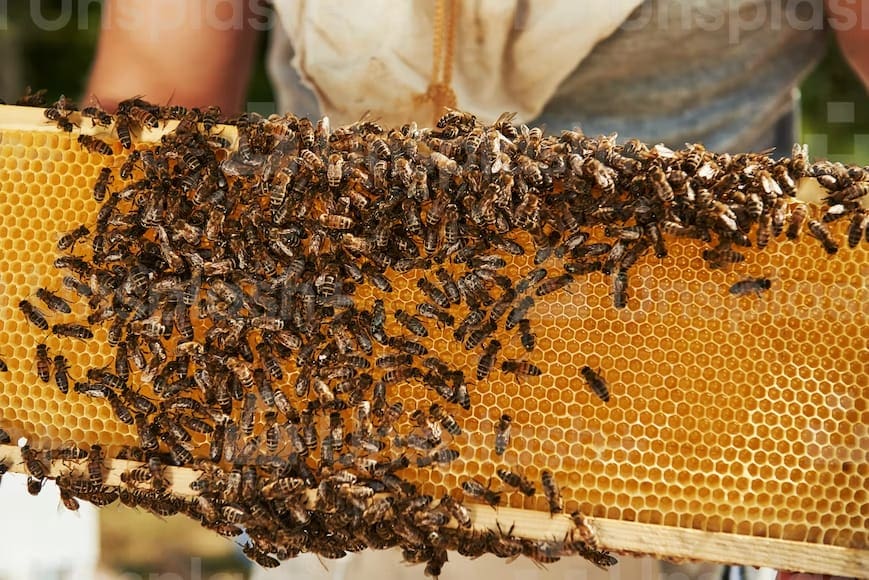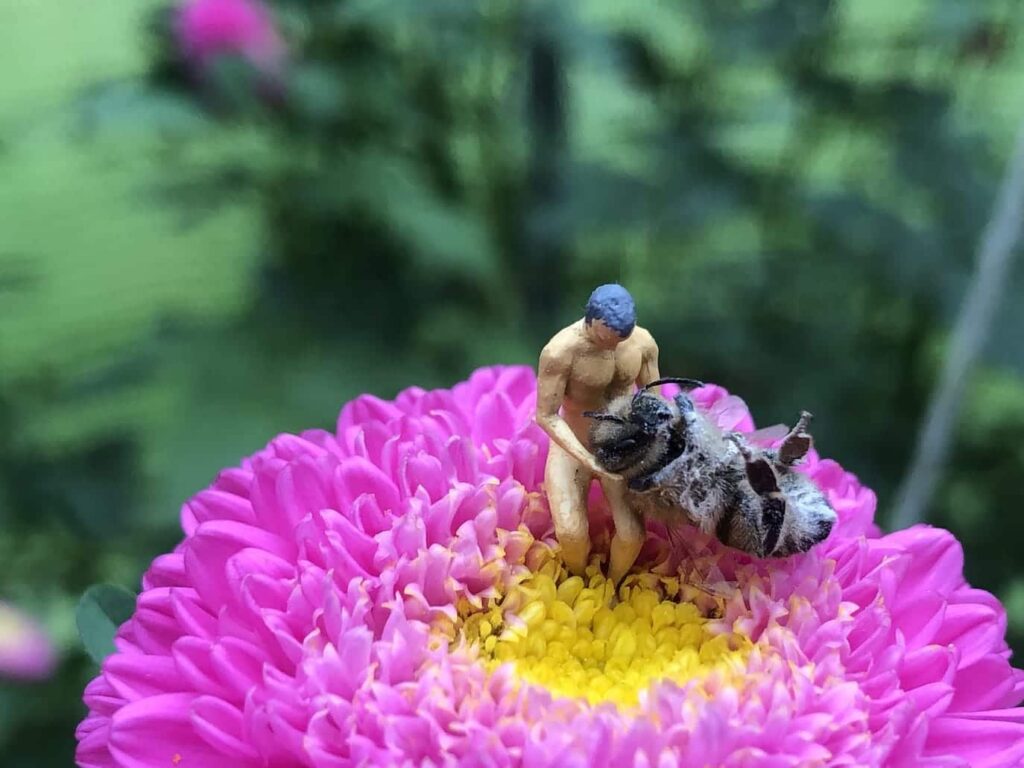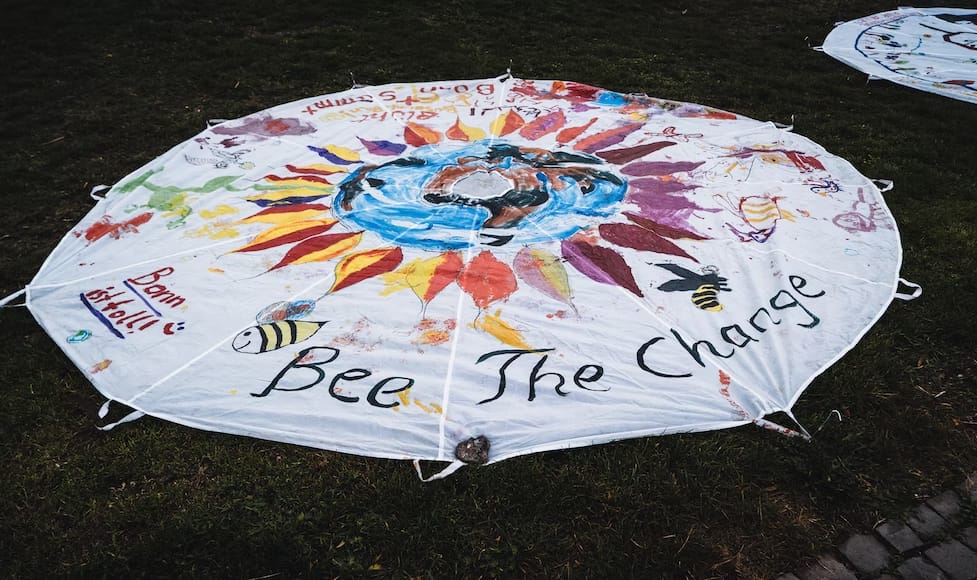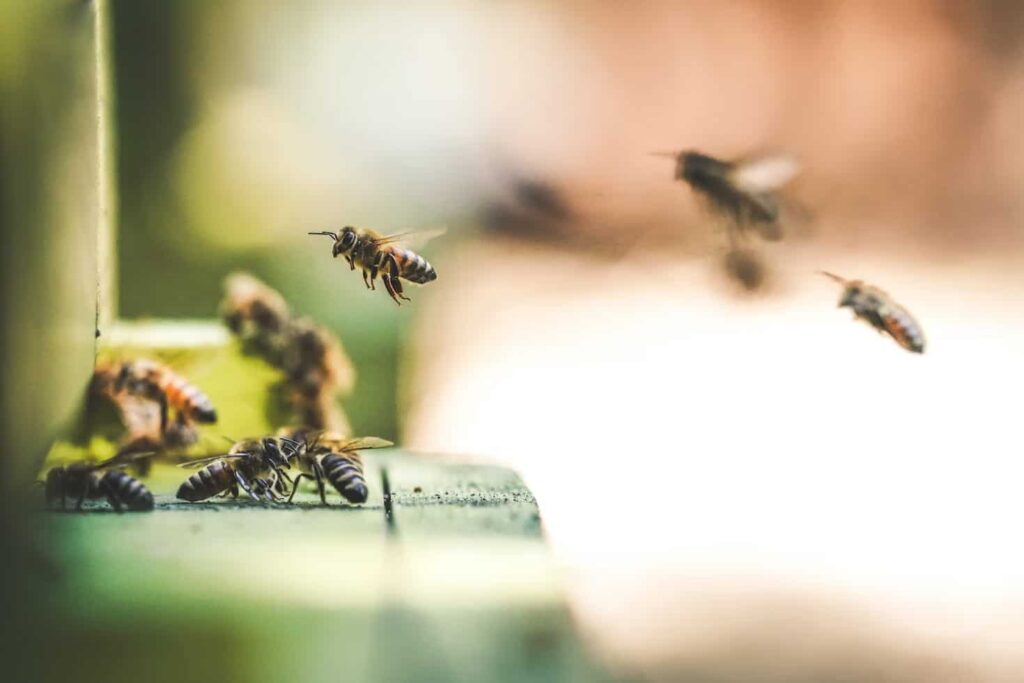Spring brings forth a life-giving orchestra of humming. Lawnmowers are moving, animals waking up from their winter naps, and the buzz of bees emerging from their hives in search of nectar to sustain them. What would a world look like without bees?
From such small creatures, they make an extraordinary contribution: over millions of years, bees and flowers have evolved together perfectly; it’s no exaggeration that we would not exist as we do now without these hapless heroes.
Unfortunately, this age-old symbiosis, this delicate dance between humans and the creatures that do their invisible work to sustain us, is being threatened. The global collapse of bee populations leads us toward potentially disastrous consequences for our ecosystems and food chain.
Let’s examine the drivers for this potential apocalyptic collapse of bee populations, why these tiny insects are a key building block to life itself, and how we play a part in their survival.

Why are Bees Important
It is no understatement that bees hold up the world’s food supply on their tiny shoulders. They pollinate over 70% of the world’s food crops. So while scientists say that in the event of a bee population collapse, humans would not likely go extinct, they might go hungry or face a severe lack of diversity in food choices.
Impact on Agriculture and Food Production
Bees play a vital role in food production as they are responsible for pollinating food crops, and helping them grow and reproduce. Around one-third of the food we eat depends on honeybees’ pollination services.
In addition, they are critical players in our economy. According to the United States Department of Agriculture, bees contribute $20-30 billion in agricultural production annually.
In addition, bees are not just responsible for food crop pollination; they also have a hand in pollinating flowering plants that supply food sources for other animals. From almonds to apples, bees help produce some of our most common food items.
Role in the Ecosystem
The smallest are often the mightiest players in our delicate global ecosystem. Pollinator species, like bees, are essential for our thriving ecosystems. While we’ve already laid out their importance in global food systems, they are also crucial to other parts of ecosystem regeneration.
Bees aid in seed dispersal for native wild plants, slowing the land degradation caused by human activity such as deforestation. This is crucial to prevent inbreeding among plant species, as bees can bring seeds from long distances. Once these trees, plants, and flowers have grown, they provide shelter for other species, and the circle of life continues.

Which Bees are Most at Risk
Bees were first placed on the Endangered Species List in 2016, based on petitions from the Center for Biological Diversity and the Bombus Pollinators Association of Law Students of Albany Law School. All seven species were of the “yellow face” variety (Hylaeus genus) and native to Hawaii.
There are also ten additional species at risk. According to the IUCN North American Bumble Bee Specialist Group, these are the bumblebee species most at risk:
- American Bumble Bee
- Crotch’s Bumble Bee
- Franklin’s Bumble Bee
- Morrison Bumble Bee
- Obscure Bumble Bee
- Rusty Patched Bumble Bee
- Southern Plains Bumble Bee
- Variable Cuckoo Bumble Bee
- Western Bumble Bee
- Yellow Banded Bumble Bee
- Yellow Bumble Bee

What is Causing the Decline in Bee Populations
Melittologist Eva Crane (yes, there is a name for one who studies bees!) placates that bees and humans have been through a lot together. Beekeeping likely predates agricultural practices from over 12,000 years ago.
While humans are usually at the core of ecosystem decline, the onus of the shrinking bee population can be found in several different areas. First, let’s look at the three most significant threats to bee populations.
Pesticides and Herbicides
The uses of pesticides and herbicides play a significant part in the decline of bees. Not only can these chemicals be toxic to them directly, but they can reduce the amount of nectar and pollen sources available, causing hives to struggle. This leaves them with fewer resources to grow in population.
Pesticides have an even more concerning effect, as they can contribute to Colony Collapse Disorder. This happens when adult bees abruptly abandon their hives and is yet another reason we need to move away from chemical-based solutions for pest control and look for more natural options that don’t impact our bees so adversely.
Habitat Destruction
Humans: great at eating the food that results from pollination, awful at maintaining the habitat of the insects that make it happen.
The destruction of bee habitats has a direct and detrimental effect on global bee populations. With healthy habitats to raise their young and forage for food, many species of bees can survive and find resources to reproduce.
This kind of destruction can take many forms, from the intentional deforestation of land to the unintentional spraying of chemicals on plants in agricultural areas. For example, Madagascar, where beekeeping provides an essential income to rural farmers, has experienced some of the highest rates of deforestation in the world, with a loss of 44% of its forests in the past 60 years.
Regardless of the method, any major environmental disruption can disrupt delicate ecosystems that bees rely on for survival, leading to population decline.
Climate Change
Rapidly changing weather patterns are impacting every type of ecosystem on earth. Climate change not only affects the trees, flowers, and other plants that bees depend on for food, but it also changes the nesting habitat for many species.
Rising temperatures can force some bee species to shift their range, while others may struggle due to a lack of territorial access. Often, feeding areas are heavily urbanized while nesting sites are isolated, creating a recipe for disaster if the two habitats do not match up.
Climate change can also induce unpredictable weather patterns, making it harder for bees to adapt and survive. It is an intricate example of how climate change can drastically alter the butterfly effect of our ecosystems.
Disease and Parasites
Bees can also face demise due to various diseases and parasites. The National Bee Pest Surveillance Program surmises that they enter sensitive foreign countries through the shipment of queen bees.
For example, Varroa Destructor Mites, a parasitic species reproducing inside honeycombs, is one notable threat facing Australia’s bee populations. As an ectoparasite, they not only directly cause harm to the bees by feeding off their blood but also transmit viruses and other infections between colonies.
This dangerous cycle continues if not managed correctly and causes a further decline in the bee population at an ever-alarming rate. In Australia, it is estimated that this parasite can decrease pollinating honey bees by more than 90%.

How Can We Help the Bees
When addressing climate change, species decline, and food systems, it can all seem overwhelming on an individual level. However, it all starts with working with what you have and starting where you are; you just have to start.
Here are some great ways to feel productive in aiding bee populations.
Planting Bee-Friendly Gardens
One of the most significant threats to bees is a lack of safe habitat. As the world develops, there are fewer places they can naturally make a safe home and find a variety of nutritious food sources.
By planting a bee-friendly garden, you can create a habitat full of plants and trees that make good homes and create a rich source of pollen and nectar. You don’t need a grand garden to make this gesture; even window boxes, flower pots, and planters can help. Think milkweed, native flowers, and even some types of trees.
Bees get most of their nectar from trees! When a tree blooms, it can provide hundreds of blooms that are an excellent food source for bees. In addition, trees make an essential habitat providing nesting material for bees and excellent shelter options. If you don’t have the space to commit to planting a tree, you can still participate by joining tree-planting parties in your area.
Reducing Pesticide Use
Skip the pesticides, fertilizers, and herbicides in your garden. These chemicals can harm bees and wreak havoc on their sensitive systems. Instead, consider organic products or natural solutions to do away with garden pests.
Build Bee Habitats
Surprisingly, with the exception of honeybees, most bees are solitary creatures. Over 70% of solitary bees live underground, while 30% live in holes inside trees.
In contrast, species like bumble bees can build their nests in undisturbed land. You can provide a safe haven for them by leaving bn island of undisturbed land in your garden. You can build a native bee habitat in your garden, Bee apartments are easy to create using old stumps with holes drilled into the center to mimic a natural beehive environment.
Support Local Beekeepers
If you can’t do any of the above, consider supporting local beekeepers. Of course, the easiest way to show appreciation is to buy locally-made honey products like soaps, lotions, and beeswax candles.
In addition, local raw honey is not only delicious but is also made from the pollen of local flora and may help with health issues like seasonal allergies.
Host a Bee Bath
Foraging is hard work, and bees get thirsty after a long day foraging for nectar and pollinating our food crops. You can create a bee watering hole by filling a shallow bird bath or bowl with clean water and pebbles and stones. The bees will land on the stones and rehydrate, and voila, you’ve created a bee rehydration station.

Key Organizations That Protect Bees
Thankfully, many non-profit groups interface with governmental entities to see that this crisis doesn’t worsen. Here are several that are working hard to ensure the future of bees.
Planet Bee Foundation
The Planet Bee Foundation out of California is dedicated to creating a green-minded generation by spotlighting the struggling bee to foster environmental literacy and stewardship through the power of individual action. Working with schools, nonprofits, summer camps, environmental centers, and community gardens, they present hands-on educational workshops.
Defenders of Wildlife
The Defenders of Wildlife was founded in 1947 as a U.S.-based national conservation organization dedicated to protecting and restoring imperiled species and their habitats in North America.
They work on a top-down level to protect and restore imperiled species throughout North America by transforming policies and institutions by promoting innovative solutions.
Xerces Society
The Xerces Society is an excellent resource for up-to-date information and has worked diligently to gain Endangered Species Act protection for two of the most imperiled species in North America: the rusty patched bumble bee and Franklin’s bumble bee.
In collaboration with Bumble Bee Watch, they track bumble bees across the United States and Canada and conduct surveys throughout North America.
Ensuring The Human Species Means Saving the Bees
As this invaluable species is being threatened by environmental changes and the activities of humans, it has become increasingly important to take proactive steps to protect them to ensure our ecosystems and food security for future generations.
Thankfully, we’re taking more steps today towards increasing the sustainability of our natural systems by investing more resources into bee conservation efforts. Any person can be a bee activist from their front yard. Promoting bee populations is just part of stewarding our shared home.
The more we understand about their hive behavior and habitat requirements – the more we can protect this critical species from a drastic number decline.
- Do Bug Zappers Kill Bees? Completely Explained - April 9, 2024
- Does Brake Cleaner Kill Bees? Full Explanation - March 20, 2024
- Do Bald-Faced Hornets Kill Honey Bees? & How to Protect Them - March 4, 2024
